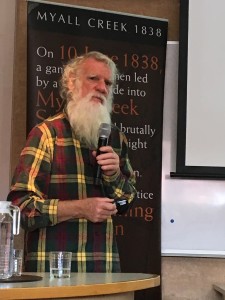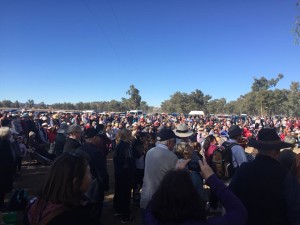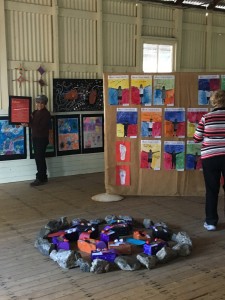Myall Creek and Beyond Symposium
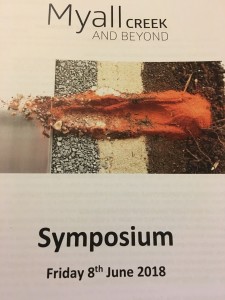
Myall Creek 1838 and beyond symposium at University of New England in Armidale was a very full day, with papers from many academics . It featured a great line up of artists, writers, poets, song writers and dancers, historians, lawyers and commentators. This word beyond to mean not just moving on but deepening and spreading the story like roots deep into the soil become the anchor of a tree.
Of course this weekend was especially focused on the 180th anniversary of the Myall Creek Massacre but many spoke of seeing beyond 1838 to find its significance in history, law and culture. And it is seen hopefully, as a reaching out to many other killing fields identified and unidentified and both still in pain.
It was especially important to meet Lyndall Ryan from Newcastle University whose paper explained the online map in which she is compiling details of massacre sites, as they meet the criteria to be designated as a place of a massacre. We have to memoralise all the sites, acknowledge and be aware, find the evidence for ordinary Australians to understand. This is an important part of the story of who we are as Australians. It can no longer he secret, hidden, whitewashed. Australia has a black history.
It is white fella business and black fella business to move forward. If we do not know and acknowledge our past we cannot be present to move into the future. Again it is like a tree, if it does not have its roots planted deeply into the earth, its present cannot be health giving and its future is one of weakness.
Myall Creek is part of a National project, a very important movement towards Reconciliation. It is a catalyst. It acknowledges Australia has a black history, and that we are prepared finally to listen.
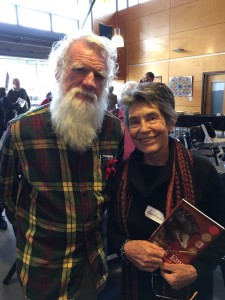
Bruce Pascoe, and myself. Bruce is the author of Dark Emu and he gave the keynote address ‘Australian’s Failure to Know its History’
My highlight was meeting the historian Bruce Pascoe, author of the well known Dark Emu and I was able to buy a new updated edition as more and more evidence comes forward and he updates the history.
His key note address was titled “Australian’s Failure to Know its History”
This is not a summary it is just my notes from his inspirational speech. ( Michael wrote notes too and comparing our noted,we realise everyone picks up different things.
Aborigine knowledge is all around us, deep in the earth, in the waters, the rivers and the lakes and high in the sky, if you but change your perspective and listen and look around .
Sometimes i sit and watch mother earth my mother talking to me: she teaches me how to behave.
We have to shift our understanding of Indigenous life. In the future the young ones, will please God learn the truth of history.
Aboriginal people had a fishing and agricultural life. They were the first agriculturalist . They had the first tools: Picks have been found , grooved where a wooden handle was held probably by reeds and spinifex glue.
Grinding stones have been found. They are the rosetta stone in telling the story of culture for starch in embedded in grooves up to 65, o00 years old. Impregnated grain in stone .
They were the first bakers. They made a nutritional bread from a grass seed.
They irrigated the springs to catch a eels high in protein . They built the first traps to catch the fish. Google fish traps of Bewarana for illustrations,detailed fishing weirs across rivers. (from diaries of Leichhardt)
They sowed seed,
they harvested crops,
they irrigated the earth.
The seed of the kangaroo grass does not need plowing,
it needs no extra water,
it needs no superphosphate
no insecticides .
Like early Australian’s old rice it was valuable. Kangaroos nibbled it for food but the first herd of sheep that came through trampled it to the ground and ate it to the bare earth. They ate the heart out of it and their hard hooves pounded the ground. So it did not rise again.
Aborigines were the first inventors of tools, the first agriculturalist with their seed
the first chemist creating dough and the first scientists, that they heated the dough making a chemical change to cook it , to make it light and sweet.
In a diary written “for 9 miles the stooked grass in bundles of sheaves stood” and Mitchell saw fields of yams stretching to the horizon,
he said’
“It was as if God had prepared the land for for me”
The aborigines traded along a great web of songlines. Trade, gossip and journey followed these lines, intricate connection of Australia.
Much research is done by Biomolecular, GIS maps, oleography and palaeography.
Much was so quickly destroyed by British occupancy. It was gone with the first herd of sheep, before records. It was gone before the reality was recognised. If we had but listened.
“ Breath there a man with soul so dead
who never to himself has said
this is my own , my own sweet country “
A British slogan yet the British went out and and took others land and pillaged their culture and their language. They needed credence, so a Papal Bull was found that said they could invade any land that did not know Jesus Christ, so occupation of soil took place under the banner of bringing the LIGHT.
Change language:
We no longer speak of bush tucker and damper and other diminutives . This is BREAD
No longer huts or humpies these are HOUSES
No longer speak of camps but TOWNS
They had the oldest towns on earth.
So you see our beautiful country is a lot more then,
‘put another shrimp on the barbie’ or
‘where the bloody hell are ya’
We have here the oldest people, oldest culture , oldest civilisation on the earth.
By the end of the Symposium I felt the grit in the oyster grinding around in our struggles and our deafness to the truth of our history. Through our mutual LISTENING it will become the the pearl of our story. And the story of Myall Creek in time is a beacon of hope. Our nation depends on us, working and walking to a shared history’
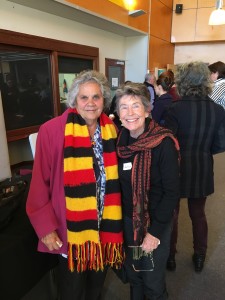
Aunty Marg and myself enjoying a break at the symposium


